Path Meander of Male Codling Moths (Cydia pomonella) Foraging for Sex Pheromone Plumes: Field Validation of a Novel Method for Quantifying Path Meander of Random Movers Developed Using Computer Simulations
Simple Summary
Abstract
1. Introduction
2. Insights from Computer Simulations
Methods and Results
3. Differential Catch of Codling Moth Males in a Trapping Grid in Apple Orchards
3.1. Methods
3.2. Results and Discussion
4. Conclusions
Author Contributions
Funding
Acknowledgments
Conflicts of Interest
References
- Katz, P.L. A long-term approach to foraging optimization. Am. Nat. 1974, 108, 758–782. [Google Scholar] [CrossRef]
- Pyke, G.H. Are animals efficient harvesters? Anim. Behav. 1978, 26, 241–250. [Google Scholar] [CrossRef]
- Stephens, D.W.; Krebs, J.R. Foraging Theory; Princeton Univ. Press: Princeton, NY, USA, 1986. [Google Scholar]
- Parker, G.A.; Smith, J.M. Optimality theory in evolutionary biology. Nature 1990, 348, 27–33. [Google Scholar] [CrossRef]
- Bell, W.J. Searching Behaviour: The Behavioural Ecology of Finding Resources; Chapman & Hall: New York, NY, USA, 1991; p. 358. [Google Scholar]
- Viswanathan, G.M.; Buldyrev, S.V.; Havlin, S.M.; da Luz, G.E.; Raposo, E.P.; Stanley, H.E. Optimizing the success of random searches. Nature 1999, 401, 911–914. [Google Scholar] [CrossRef]
- Sakiyama, T.; Gunji, Y.-P. Emergence of an optimal search strategy from a simple random walk. J. R. Soc. Interface 2013, 10, 1–6. [Google Scholar] [CrossRef]
- O’Brien, W.J.; Browman, H.I.; Evans, B.I. Search strategies of foraging animals. Am. Sci. 1990, 78, 152–160. [Google Scholar]
- Hill, N.A.; Hädler, D.P. A biased random walk model for the trajectories of swimming micro-organisms. J. Theor. Biol. 1997, 186, 503–526. [Google Scholar] [CrossRef]
- Hall, R.L. Amoeboid movement as a correlated random walk. J. Mathmat. Biol. 2015, 4, 327–335. [Google Scholar] [CrossRef]
- Broadbent, S.R.; Kendall, D.G. The random walk of Trichostrongylus retortaeformis. Biometrics 1953, 9, 460–466. [Google Scholar] [CrossRef]
- Helms, S.J.; Avery, L.; Stephens, G.J.; Shimizu, T.S. Modelling the ballistic-to-diffusive transition in nematode motility reveals low-dimensional behavioral variation across species. arXiv 2015, arXiv:1501.00481v2. [Google Scholar]
- Kareiva, P.M.; Shigesada, N. Analyzing insect movement as a correlated random walk. Oecologia 1983, 56, 234–238. [Google Scholar] [CrossRef]
- Crist, T.O.; MacMahon, J.A. Individual foraging components of harvester ants: Movement patterns and seed patch fidelity. Insectes Sociaux 1991, 38, 379–396. [Google Scholar] [CrossRef]
- Nagasaka, K.; Mase, K.; Okada, E.; Yamamoto, T. Analyzing dispersal of silkworm larvae as a random process. J. Sericultural Sci. Jpn. 1998, 67, 101–107. [Google Scholar]
- Byers, J.A. Correlated random walk equations of animal dispersal resolved by simulations. Ecology 2001, 82, 1680–1690. [Google Scholar] [CrossRef]
- Bengtsson, G.; Nilsson, E.; Ryden, T.; Wiktorsson, M. Irregular walks and loops combine in small-scale movement of a soil insect: Implications for dispersal biology. J. Theor. Biol. 2004, 231, 299–306. [Google Scholar] [CrossRef]
- Miller, J.R.; Adams, C.G.; Weston, P.A.; Schenker, J.H. Trapping of Small Organisms Moving Randomly: Principles and Applications to Pest Monitoring and Management; Springer Briefs in Ecology, Springer: Heidelberg, Germany, 2015; p. 114. [Google Scholar]
- Adams, C.G.; Schenker, J.H.; McGhee, P.S.; Gut, L.J.; Brunner, J.F.; Miller, J.R. Maximizing information yield from pheromone-baited monitoring traps: Estimating plume reach, trapping radius, and absolute density of Cydia pomonella (Lepidoptera: Tortricidae) in Michigan apple. J. Econ. Entomol. 2017, 110, 305–318. [Google Scholar] [CrossRef]
- Berg, H.C. Random Walks in Biology; Princeton University Press: Princeton, NJ, USA, 1993; p. 168. [Google Scholar]
- Codling, E.A.; Plank, M.J.; Benhamou, S. Random walk models in biology. J. R. Soc. Interface 2008, 5, 813–834. [Google Scholar] [CrossRef]
- Svensson, G.P.; Valeur, P.G.; Reynolds, D.R.; Smith, A.D.; Riley, J.R.; Baker, T.C.; Guy, M.; Poppy, G.M.; Löfstedt, C. Mating disruption in Agrotis segetum monitored by harmonic radar. Entomol. Expt. Appl. 2001, 101, 111–121. [Google Scholar] [CrossRef]
- Wehner, R.; Wehner, S. Insect navigation: Use of maps or Ariadne’s thread? Ethol. Ecol. Evol. 1990, 2, 27–48. [Google Scholar] [CrossRef]
- Hill, S.; Burrows, M.T.; Hughes, R.N. Increased turning per unit distance as an area-restricted search mechanism in a pause-travel predator, juvenile plaice, foraging for buried bivalves. J. Fish Biol. 2000, 56, 1497–1508. [Google Scholar] [CrossRef]
- Lynch, J.F.; Balinsky, E.C.; Vail, S.G. Foraging patterns in three sympatric forest ant species, Prenolepis impairs, Paratrechina and Aphaenogaster rudis (Hymenoptera: Formicidae). Ecol. Entomol. 1980, 5, 353–371. [Google Scholar] [CrossRef]
- Pearce-Duvet, J.M.; Elamans, C.P.H.; Fenner, D.F., Jr. Walking the line: Search behavior and foraging success in ant species. Behav. Ecol. 2011, 22, 501–509. [Google Scholar] [CrossRef]
- Bond, A. Optimal foraging in a uniform habitat: The search mechanism of the green lacewing. Anim. Behav. 1980, 28, 10–19. [Google Scholar] [CrossRef]
- Nakamuta, K. Mechanism of the switchover from extensive to area-concentrated search behavior of the ladybird beetle, coccinella septempunctata bruckii. J. Insect Phys. 1985, 31, 849–856. [Google Scholar] [CrossRef]
- Nurzaman, S.G.; Matsumoto, Y.; Nakamura, Y.; Shirai, K.; Koizumi, S.; Ishiguro, H. From Levy to Brownian: A computational model based on biological fluctuation. PLoS ONE 2011, 6, 1–11. [Google Scholar] [CrossRef]
- Ferran, A.; Ettifouri, M.; Clement, P.; Bell, W.J. Sources of variability in the transition from extensive to intensive search in coccinellid predators (Homoptera: Coccinellidae). J. Insect Behav. 1994, 7, 633–647. [Google Scholar] [CrossRef]
- Bovet, P.; Benhamou, S. Optimal sinuosity in central place foraging movements. Anim. Behav. 1991, 42, 57–62. [Google Scholar] [CrossRef]
- Sokolowski, M. Foraging strategies of Drosophila melanogaster: A chromosomal analysis. Behav. Genet. 1980, 10, 291–302. [Google Scholar] [CrossRef]
- Edelhoff, H.; Signer, J.; Balkenhol, N. Path segmentation for beginners: An overview of current methods for detecting changes in animal movement patterns. Mov. Ecol. 2016, 4, 21. [Google Scholar] [CrossRef]
- Riley, J.R. Flying Insects in the field. In Video Techniques in Animal Ecology and Behaviour; Wratten, S.D., Ed.; Chapman & Hall: London, UK, 1993; pp. 1–15. [Google Scholar]
- Noldus, L.P.; Spink, A.J.; Tegelenbosch, R.A.J. Computerized video tracking, movement analysis and behaviour recognition in insects. Comput. Electron. Agric. 2002, 35, 201–227. [Google Scholar] [CrossRef]
- Cardé, R.T.; Cardé, A.M.; Girling, R.D. Observations on the flight paths of the day-flying moth Virbia lamae during periods of mate location: Do males have a strategy for contacting the pheromone plume? J. Anim. Ecol. 2012, 81, 268–276. [Google Scholar] [CrossRef]
- Bau, J.; Cardé, R.T. Modeling optimal strategies for finding a resource-linked windborne odor plume: Theories, robotics and bionomic lessons from flying insects. Integr. Comp. Biol. 2015, 55, 461–477. [Google Scholar] [CrossRef]
- Espinoza, M.; Farrugia, T.J.; Webber, D.M.; Smith, F.; Lowe, C.G. Testing a new acoustic telemetry technique to quantify long-term, fine-scale movements in aquatic animals. Fish. Res. 2011, 108, 364–371. [Google Scholar] [CrossRef]
- Jain, V.R.; Bagree, R.; Kumar, A.; Ranjan, P. wildCENSE: GPS Based Animal Tracking System. In Proceedings of the 2008 International Conference on Intelligent Sensors, Sensor Networks and Information Processing, Sydney, Australia, 15–18 December 2008; IEEE: New York, NY, USA, 2008; pp. 617–622. [Google Scholar]
- Riecken, U.; Ulrike, R. Use of radio telemetry for studying dispersal and habitat use of Carabus coriaceus L. Annl. Zoo. Fenn. 1996, 33, 109–116. [Google Scholar]
- Cagnacci, F.; Boitani, L.; Powel, R.A.; Boyce, M.S. Animal ecology meets GPS-based radiotelemetry: A perfect storm of opportunities and challenges. Philos. Trans. R. Soc. B 2010, 365, 2157–2162. [Google Scholar] [CrossRef]
- Vinatier, F.; Chailleux, A.; Duyck, P.; Salmon, F.; Lescourret, R.P.; Tixier, P. Radiotelemetry unravels movements of a walking insect species in heterogeneous environments. Anim. Behav. 2010, 80, 221–229. [Google Scholar] [CrossRef]
- Wikelski, M.; Moxley, J.; Eaton-Mordas, A.; Lopez-Uribe, M.M.; Holland, R.; Moskowitz, D.; Roubik, D.W.; Kays, R. Large-range movements of neotropical orchid bees observed by radio telemetry. PLoS ONE 2010. [Google Scholar] [CrossRef] [PubMed]
- Walden-Schreiner, C.; Leung, Y.-F.; Kuhn, T.; Newburger, T. Integrated direct observation and GPS tracking to monitor animal behavior and resource management. Environ. Monit. Assess. 2018, 190, 75. [Google Scholar] [CrossRef] [PubMed]
- Trematerra, P.; Gentile, P.; Sciarretta, A. Spatial analysis of pheromone trap catches of codling moth (Cydia pomonella) in two heterogeneous agroecosystems, using geostatistical techniques. Entomology 2004, 32, 325–341. [Google Scholar]
- Witzgall, P.; Stelinski, L.; Gut, L.; Thomson, D. Codling moth management and chemical ecology. Annu. Rev. Entomol. 2008, 53, 503–522. [Google Scholar] [CrossRef]
- Thomson, D.R.; Gut, L.J.; Jenkins, J.W. Pheromones for insect control: Strategies and successes. In Biopesticides Use and Delivery; Hall, F.R., Menn, J.J., Eds.; Humana Press: Totowa, NJ, USA, 1999; pp. 385–412. [Google Scholar]
- Allison, J.D.; Cardé, R.T. (Eds.) Pheromone Communication in Moths; University of CA Press: Oakland, CA, USA, 2016; p. 400. [Google Scholar]
- Tiwari, K.; Chong, N.Y. (Eds.) Multi-Robot Exploration for Environmental Monitoring; The Resource Constrained Perspective; Academic Press: London, UK, 2019; p. 276. [Google Scholar]
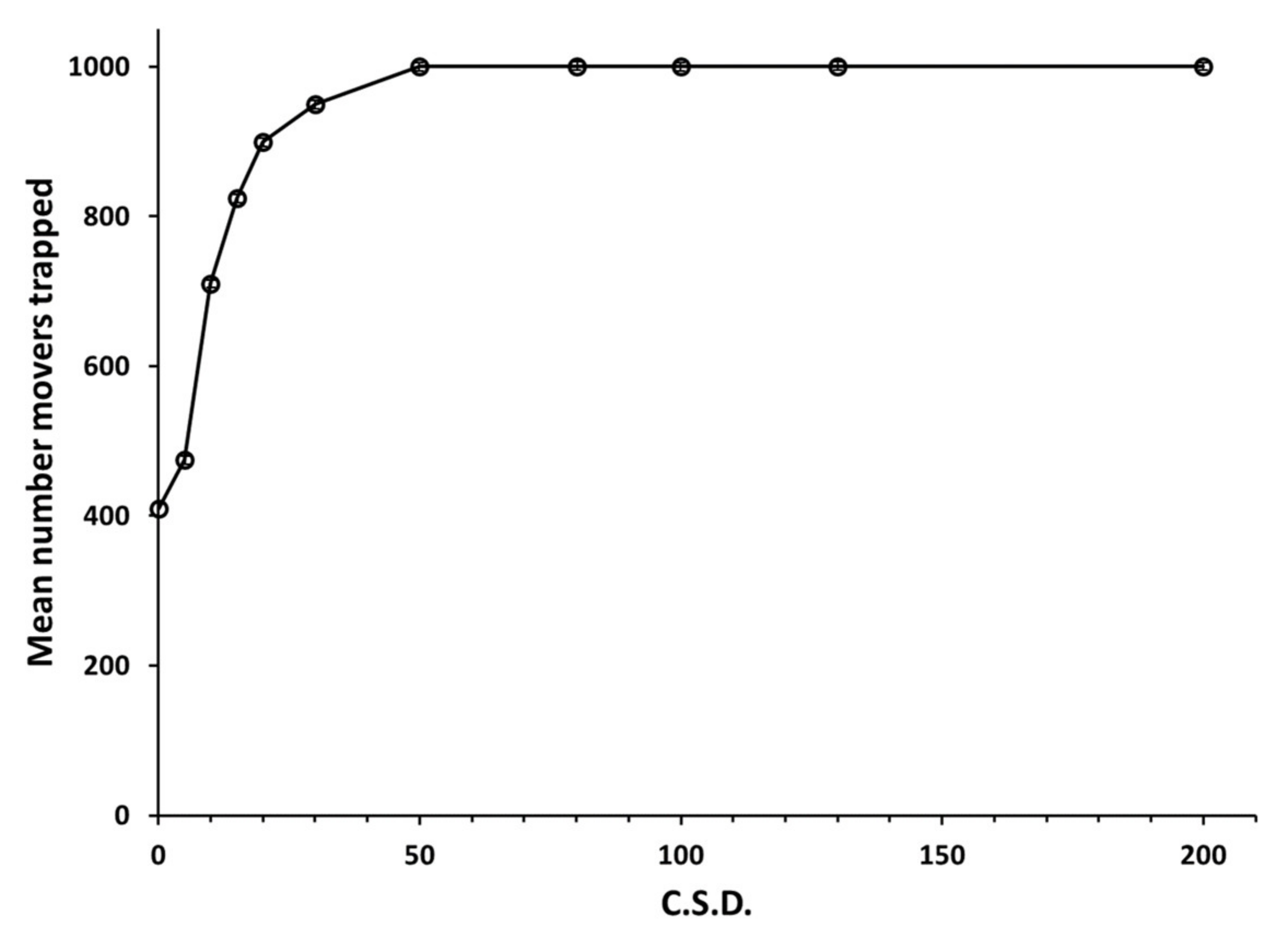

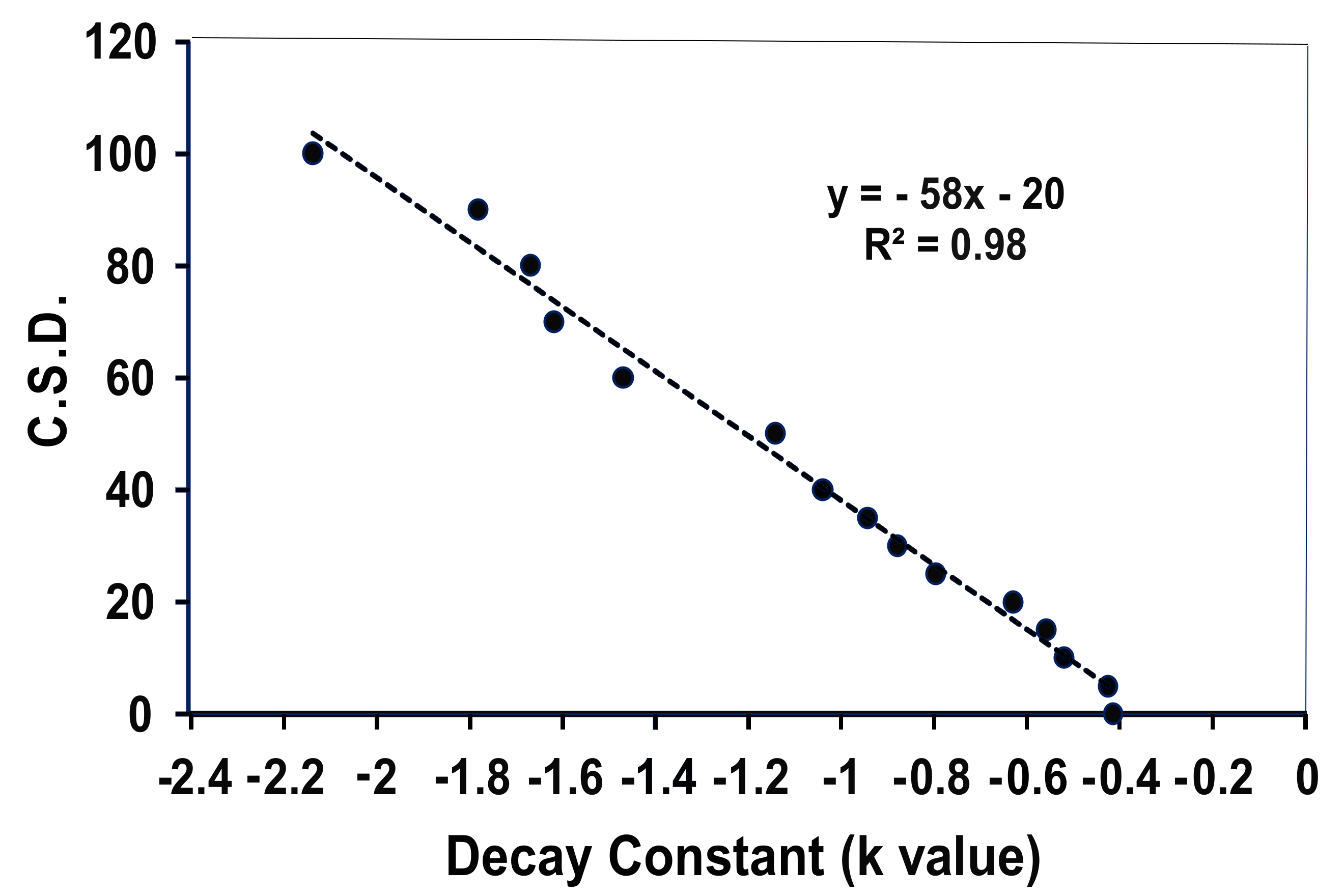
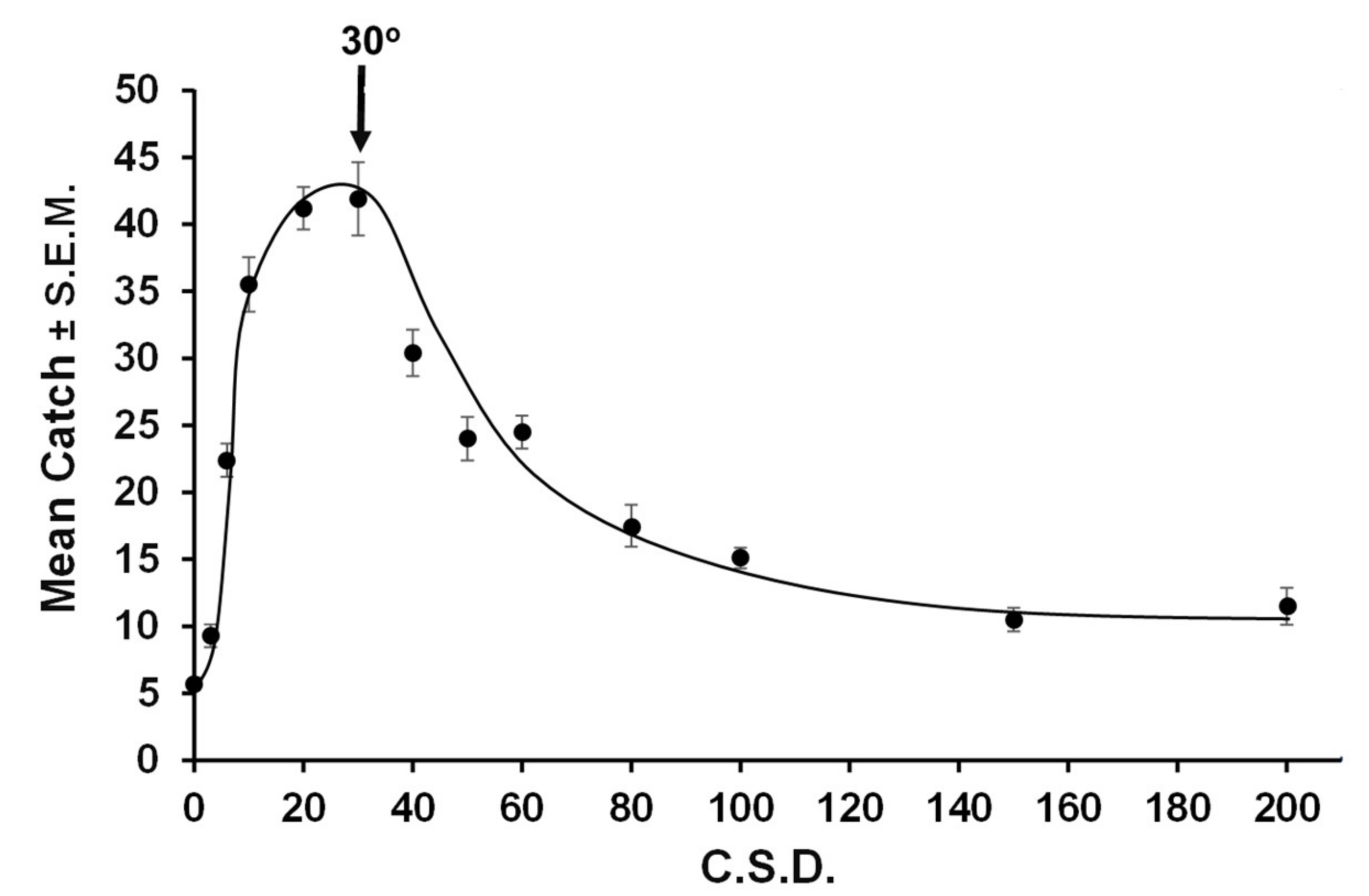
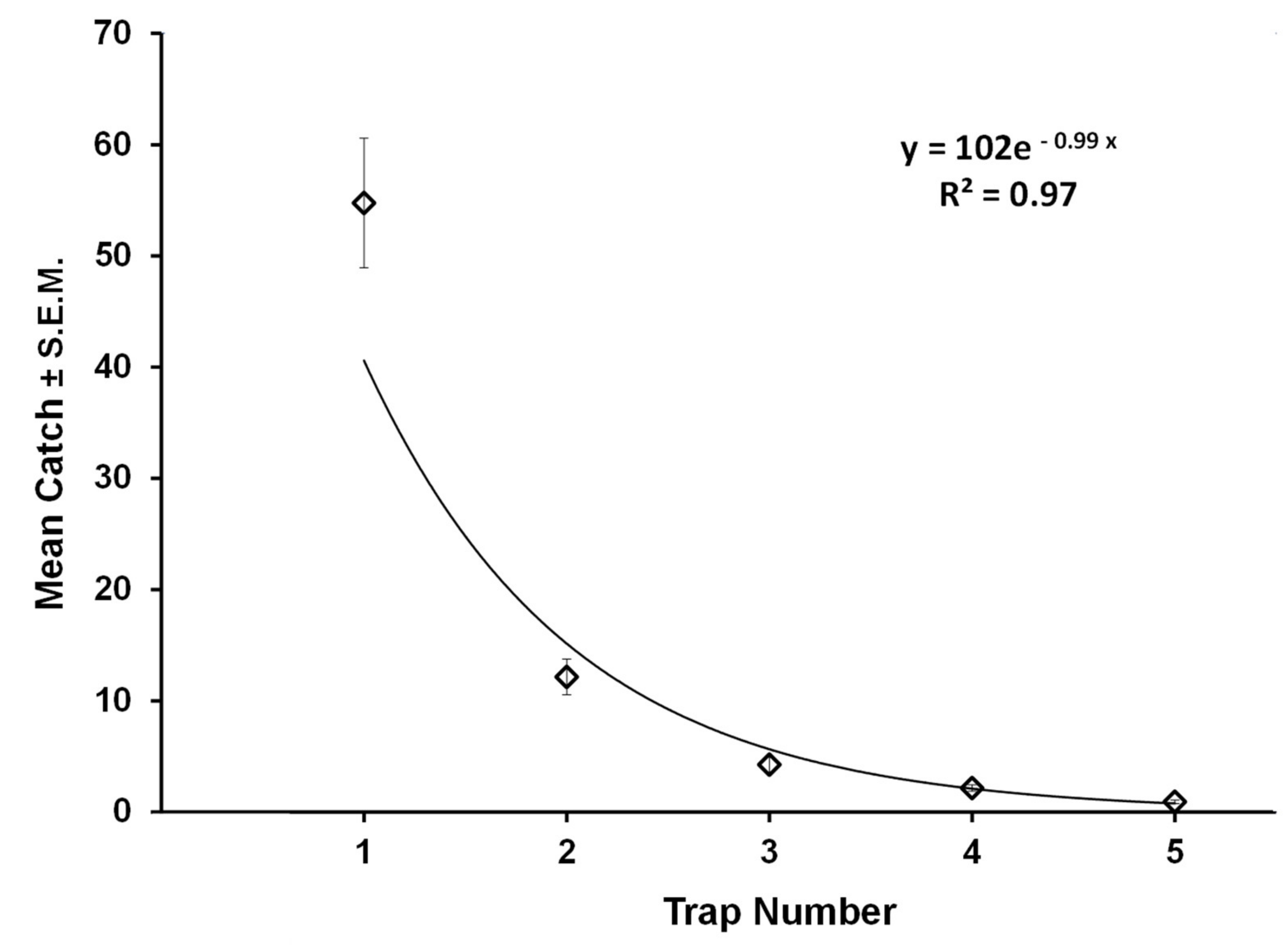
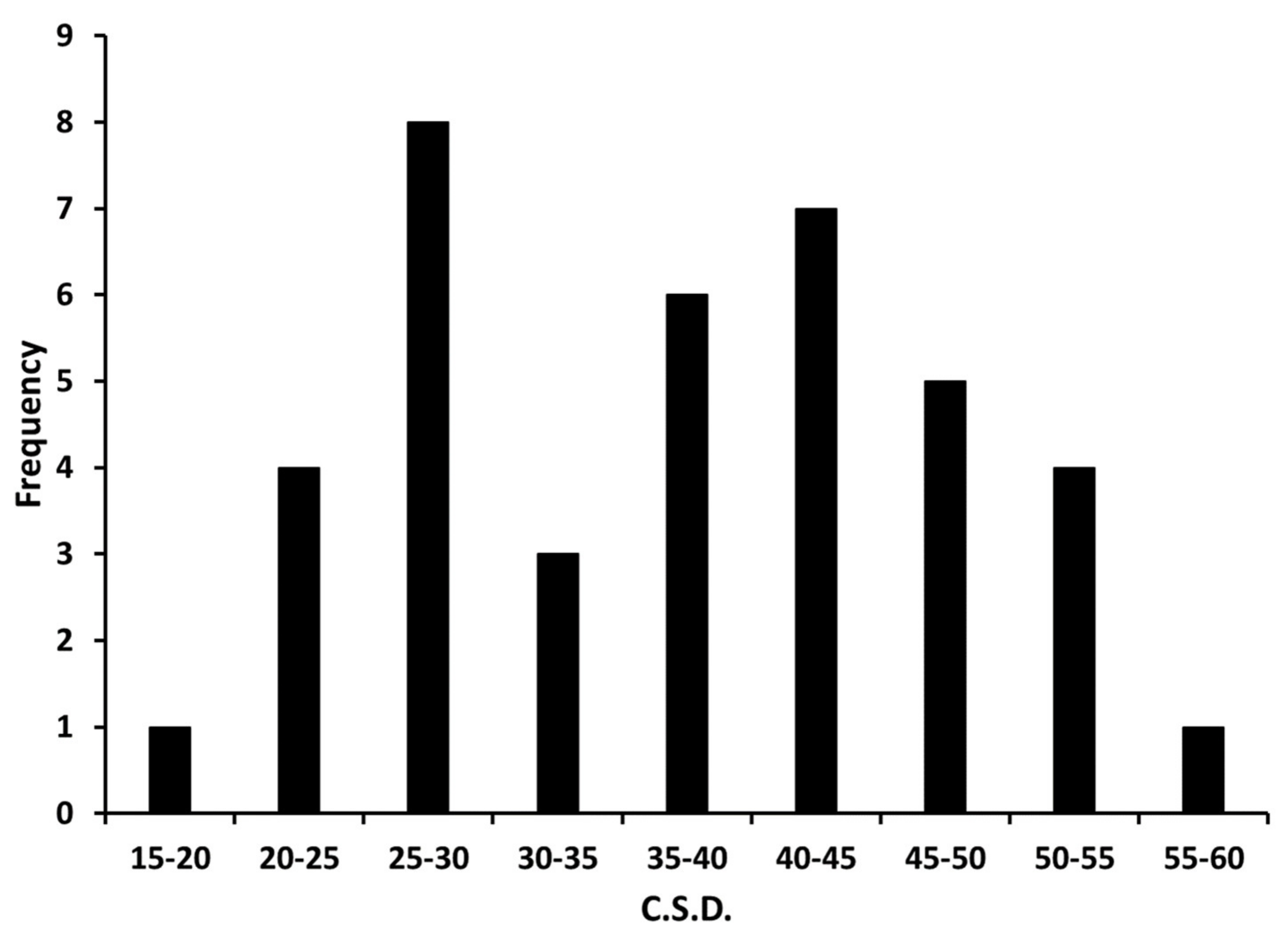
© 2020 by the authors. Licensee MDPI, Basel, Switzerland. This article is an open access article distributed under the terms and conditions of the Creative Commons Attribution (CC BY) license (http://creativecommons.org/licenses/by/4.0/).
Share and Cite
Adams, C.; Schenker, J.; Weston, P.; Gut, L.; Miller, J. Path Meander of Male Codling Moths (Cydia pomonella) Foraging for Sex Pheromone Plumes: Field Validation of a Novel Method for Quantifying Path Meander of Random Movers Developed Using Computer Simulations. Insects 2020, 11, 549. https://doi.org/10.3390/insects11090549
Adams C, Schenker J, Weston P, Gut L, Miller J. Path Meander of Male Codling Moths (Cydia pomonella) Foraging for Sex Pheromone Plumes: Field Validation of a Novel Method for Quantifying Path Meander of Random Movers Developed Using Computer Simulations. Insects. 2020; 11(9):549. https://doi.org/10.3390/insects11090549
Chicago/Turabian StyleAdams, Christopher, Jeffrey Schenker, Paul Weston, Lawrence Gut, and James Miller. 2020. "Path Meander of Male Codling Moths (Cydia pomonella) Foraging for Sex Pheromone Plumes: Field Validation of a Novel Method for Quantifying Path Meander of Random Movers Developed Using Computer Simulations" Insects 11, no. 9: 549. https://doi.org/10.3390/insects11090549
APA StyleAdams, C., Schenker, J., Weston, P., Gut, L., & Miller, J. (2020). Path Meander of Male Codling Moths (Cydia pomonella) Foraging for Sex Pheromone Plumes: Field Validation of a Novel Method for Quantifying Path Meander of Random Movers Developed Using Computer Simulations. Insects, 11(9), 549. https://doi.org/10.3390/insects11090549





